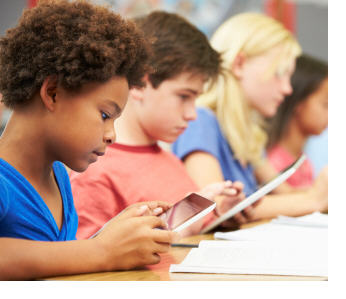
Digital Tablets May Improve Classroom Learning
June 26, 2013—During 2012-2013, over 2,000 pupils and 150 teachers in early childhood, primary, secondary and special education, took part in a study to identify the best learning activities with tablets, and the advantages and disadvantages of using them.
During this study, coordinated by Pere Marquès, director of the group Didactics, Innovation and Multimedia (DIM-UAB) of the Universitat Autònoma de Barcelona's Department of Applied Education Studies, the pupils' main activities were searching for information on internet (consulting encyclopaedias, the press and web 2.0 environments); watching and listening to audiovisuals (music, cartoons and videos); taking photos and making video and audio recordings; using office applications (text editing, multimedia presentations and spreadsheets); communicating with classmates or the teacher (by e-mail or on social networks); searching the internet for resources on the lesson and showing these on the digital whiteboard; doing exercises with educational applications and other resources available through browsers; taking notes (voice or text), drawing, and sharing information and files, among others.
Half the schools in the study used the tablets more than 30% of weekly class time, and 73% of the pupils also worked with the tablet at home. 45% of the devices were the students' own property.
The study highlights a large number of advantages in using digital tablets, such as access to sources of information on internet and the tablet's portability and multifunctionality, providing resources for different learning activities.
Furthermore, the researchers believe that digital tablets lead teachers to apply student-centred, empowering methodologies, help to deal with diversity among pupils (by personalising content and practice activities), spread digital skills within the family and facilitate the use of collaborative information-sharing environments. One significant disadvantage observed during the study, is that over 90% of the teachers believe that these devices increase class-preparation time, especially time spent searching for and creating resources for the pupils.
The study highlights the impact on pupils' learning. 87% of teachers claim that tablets contribute to the improvement of pupils' learning in general. Over 90% state that they facilitate independent learning (as they provide interaction and tools), help develop pupils' digital skills, improve comprehension (through images, simulations and video), encourage creativity (by helping to find and organise information and discuss ideas), and increase pupils' involvement and motivation.
However, less than 60% of teachers think that pupils' academic performance also improves, or in other words, the impact on their marks is seen to be lower than on their learning.
In the words of Pere Marquès, "the curricular framework, and especially the traditional assessment system, prevent pupils from displaying all they have learnt." In order to achieve a real improvement in academic performance, the experts advocate a bimodal curriculum, which recent research suggests would allow improved learning to be reflected in much better academic results.
ABOUT UAB:
The Times Higher Education ranking of the best universities in the world under 50 years old puts the UAB in 22nd place, the highest of all universities in Spain.
